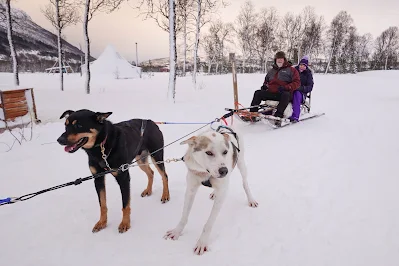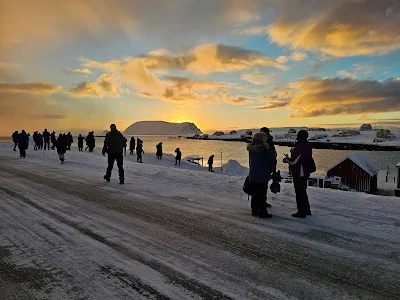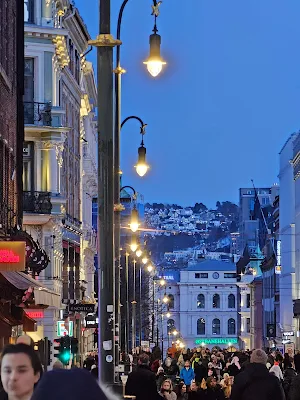 |
Greetings from Norway! This month I'm going to share with you three things that actually surprised me (and that's not easy to do!) while processing my vacation images. So let's get right to it.
1) Adobe's new AI-based Noise Reduction
So here we were, getting onto a small boat to travel to where the eagles nest in order to take pictures. It was a miserable day and I was shooting in the worst light possible. Armed with my RX-10 IV (my favorite travel camera due to its insane lens) I took about 450 shots, using the spray-and-pray approach. Shutter priority mode, 1/4000th of a second, Auto ISO. The RX-10 IV had no problem tracking these birds in such poor conditions.
Back at the computer, I identified a few potentially usable shots which were horribly underexposed. But because I had shot in RAW + JPG, I felt there was a chance of turning them into usable shots. Here's the most promising of the bunch:
 |
| Horrible exposure. Can it be saved? |
 |
| 100% crop. |
 |
| 100% Crop |
2) Adobe's Generative Fill
Here's a picture I took from our hotel room in Oslo:
It's nice enough, but I wanted to add a splash of color. So using Photoshop's new tools, I selected the sky and used the new EDIT --> Generative Fill tool, where you enter a brief description of what you want the space filled with: "A gentle sunrise".
Don't like the result? Put in the same description again and it will generate something different.
When this ends up on the Friedman Archives website, I will mention the fact that the sky was replaced, as is my policy.
I'll get to the third thing after some announcements.
SOME ANNOUNCEMENTS
Next Seminars!
Next year will mark the 25th anniversary of the Friedman Archives (has it really been that long?), and that might be an ideal time to retire. In the meantime, these will probably be the last seminars I'll be conducting (not counting a big one I'm planning for 2025 - stay tuned).
Plymouth, Massachusetts (an hour south of Boston) - April 27-28, 2024
Florence, Alabama - (Not far from Huntsville and Nashville) Sponsored by the Quad Cities Photography Club (The Shoals) - September 14-15, 2024
Kansas City, Kansas - Sponsored by Digital Dimensions and Beyond Camera Club - September 21-22, 2024
Are you a member of a photo club? Have them contact me for a mutually beneficial offer!
In the Pipeline
OM Digital OM-1 II and the Sony A9 III are both in the works! Email me (Gary at Friedman Archives dot com) if you'd like to be on the notification lists.
Next Time in Cameracraft Magazine
Mary Ellen Mark’s camera strap dangled from Florence Montmare’s Nikon D850 as she was shooting a portrait of a random person she met in Newark, New Jersey. He was homeless, jobless, and his girlfriend just recently drained his bank account and split. Despite all that, he agreed to have his portrait taken and sign a model release. In California, an African-American woman shared her story about being stopped and frisked without cause.
These are just two of hundreds of random encounters that Montmare had on her trip back and forth across the United States, a cross-country portrayal of America, a popular theme that few female photographers have explored.
The next issue also showcases the work of Mitchell Kanashkevich, who lives in a motorhome and travels the world with his wife and daughter, making a living as a travel photographer and teacher. Subscribe to Cameracraft Magazine today and live vicariously through others! :-)
Safari Update
The Kenya Safari in November, 2024 is almost full - there are just two rooms (4 beds) left. More info and sign up at https://FriedmanArchives.com/safari
Continuing...
3) Photographing the Northern Lights
I'm no stranger to shooting Northern Lights. Below is a time lapse video I made a few years ago taken from the deck of a moving ship:
I also have taken some great Northern Lights pictures in Iceland in the past:
 |
| Carol holding still for a 10-second shot. I suppose I could have used fill flash here, but the final image would have looked either fake or ugly (or both) |
On this trip, the northern lights were barely visible, and I tried using the same time lapse technique using the RX100 VII; 20 seconds, ISO 4000 on a tripod and post processed a little for noise reduction. And for fun, I also tried it using my smartphone - five seconds, handheld with NO TRIPOD and no post processing
 |
| RX100 VII |
The smartphone captured what I saw better!
If you've been reading my blog for any length of time, you'll know how impressed I am of the computational abilities of the latest generation of smartphones, allowing it to finally fulfill the promise of point-and-shoots ever since point-and-shoots were invented. And while it's usually possible to take the RAW files from the bigger cameras and make them look as good as the smartphone images by investing a lot of time, in this case that just wasn't possible.
Other shots from this trip
 |
| At North Cape, the northmost point in Europe. |
 |
| Really Good Light |
 |
| Oslo Opera House |
 |
| Opera House Interior (Isn't it good? Norwegian Wood!) |
 |
| Munch Museum |


























I was just in Oslo and Bergen this past summer - thank you for the cool pics. More would not bore me.
ReplyDeleteEnjoy yourself Gary. Norway is one of my favorite countries to visit. We cruised the fjords on a Hurtigruten ship back in 2017 and it was wonderful.
ReplyDeleteThat anonymous comment above referencing the Hurtigruten line is from me Gary. I'm looking forward to hearing of your impressions of the A9 III
ReplyDeleteHi, John! I'm certain I'll be talking about it a lot in my next blog post. :-)
DeleteYou're living the good life Gary! Dog sledding in Norway! Guess you can't be missing California too much while having as much fun as you're having. It's always fun to see your blog posts but when I saw the title "Three amazing surprises from Norway" that was a click-thru priority for me since I'm Norwegian. Yes, that third surprise... so true; still like having both but, eventually....
ReplyDeleteYes, I shot with both as well but I find that the pics from the phone rarely need post processing, even in difficult light.
DeleteGary, so glad to hear that you use your RX10IV while traveling. I purchased a used one a few months ago. The 24-600mm equivalent lens is awesome. I just wish that Sony would update the camera to use the NP-FZ100 battery and their newest menu system.
ReplyDeleteI'm hoping for an update as well, and I have a short list of features I'd like to see - starting with the ability to power down the camera after XXX seconds of inactivity but without retracting the lens. (Newer Sony cameras have it... this one REALLY needs it because the turn on / turn off time is so slow.)
DeleteRegarding AI, perhaps try asking for a view from a hotel room in Norway with glass roof in the foreground and a gentle sunrise? That way there’s no need to carry a camera at all. Thinking further, no need to leave the comfort of your couch!
ReplyDelete:-) :-)
DeleteHey, John! Send me an email; let's catch up!
ReplyDeleteIs there a recommended shutter speed for capturing Northern Lights? I'm wondering if 20 seconds was too long. Like taking a picture of a stream or waterfall or waves on a lake. 20 seconds (with ND filter) and the details are smoothed out. Works with water, but not good for Northern Lights?
ReplyDeleteAs with most things in photography, the answer is almost always "It depends". In this case, it depends on how bright the lights are, how fast your lens, and what ISO you have set. I've never encountered a situation where 20 seconds was too long.
DeleteNorway is on my to do list, just super scared for prices, i feel it's even more expensive then Swiss (i managed a jam packed trip to Swiss for 14 days, with literaly all activities (mostly expensive train related), in 1600€, if i didn't hunt for price efficiency it easely could have costed 4300€ (especially were we slept is already 80% cheaper then second cheapest spot in same town :D
ReplyDeleteFond memories aroused of our trip round Norway 30 years ago, shooting with film 😀😉. Stunning pictures Gary.
ReplyDeleteThank you! I'm glad I was able to jog a neuron.
DeleteGary, I am impressed by your continued enthusiasm for serious photography. My phone is my only real camera these days. My Sony RX-100 VII has been turned into a good webcam, and my Nikon D-850 and super nice lenses are all gathering dust on my shelves. Something about the COVID shutdown killed the hobby for me. (I did shoot one wedding during COVID, but that's the last time I did any serious photography.) I'm glad to hear about the updates to PS because I still pay for my subscription.
ReplyDeleteYou are not alone, and please don't think smartphone use is somehow "not serious". Most of the images on this page were taken with the Samsung S23 Ultra. It handles bad light better than my bigger cameras. See https://friedmanarchives.blogspot.com/2021/09/computational-photography.html
DeleteI would never be bored by great images and interesting engineering. I was in Bergin a few years ago on a cruise and the scenery blew my mind away. I got some great shots there.
ReplyDeleteThanks, Kevin! Hard to get bad pictures in Bergen.
DeleteGary, I have many bird photos that are a bit off, but could be good. I'd be very interested to hear a comparison of your Adobe processing with Topaz, which I have found to be often outstanding in sharpening and denoising marginal wildlife shots.
ReplyDeleteThanks, Phil
Hi, Phil. Next month's blog will take the eagle picture and have it processed by DxO and Topaz and will show a comparison of the results.
DeleteI'm waiting for that comparison because I found the Adobe denoise image to be 'smeared'. I've found Topaz DeNoise and Topaz Photo AI do a far better job.
DeleteHi Gary! I will be in Norway in July, so I am enjoying your photos. My only “good”camera is the Sony RX10 M4, which I absolutely love.
ReplyDeleteI have found the Lightroom Denoise feature to be outstanding as well, although based on what I have read online, I first reduce the sharpening slider to zero before applying it. Then I apply a mask over the subject(s) and increase the sharpness slider to the point just before artifacts begin. What has your experience been in that regard?
Also, I have recently found a different workflow using Topaz Sharpen AI, which typically yields superior results to using LR Denoise plus sharpening with a mask, namely, reduce the LR sharpening slider to zero; apply Denoise; on the new dng file apply a mask to the subject(s) that need sharpening and increase the sharpening slider to 30; and then send the dng file to Topaz Sharpen AI for tweaking which invariably requires me to lower the “Remove Blur” slider to 10 or less, but the results are most impressive. Wonder if you could try that for next months blog.
As always, love your blog!